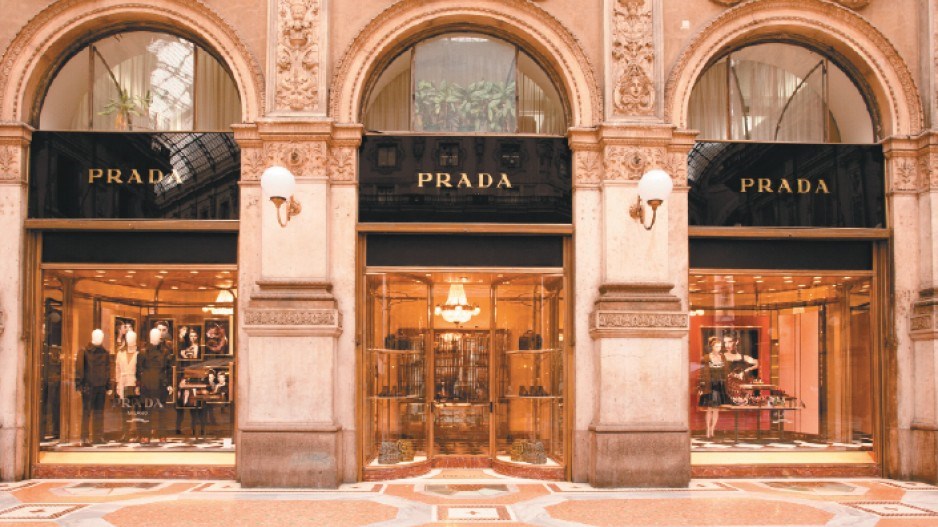There is a sharp dip in the global market for luxury goods this year, in large part because of changing buying habits by wealthy Chinese and a campaign by President Xi Jinping to stamp out extravagant living.
Boston-based consultancy firm Bain & Co., respected analyst of the luxury goods industry, says in its latest report it expects the worldwide growth to be only 2% this year at current exchange rates.
That's down from a 10% growth last year and 30% in 2011.
However, the global market for high-end clothing, watches, perfumes, cosmetics, jewelry and other accessories such as ties, shoes and belts is still worth close to $300 billion a year.
A major element in this slowing, according to the Bain report, is the deceleration of growth in the Chinese luxury-goods market. Growth is expected to be only 2.5% this year, down from 20% last year.
The main areas of growth in the market now appear to be Southeast Asia and the Americas, says the report. However, this picture is deceptive, says Bain, because many Chinese now prefer to buy their luxury goods abroad.
About 80 million Chinese travelled abroad as tourists last year, and, according to a survey done for Hong Kong's Trade Development Council, 37% of them bought an international luxury product that cost more than their monthly incomes.
Bain & Co. estimates that Chinese buyers represent 29% of luxury-goods consumers worldwide.
There are several reasons why Chinese are changing their shopping habits.
One is weaker economic growth in China, which has deterred the lower end of China's middle class from splurging on status-symbol handbags, watches and so forth.
Another is the huge price gap between luxury goods sold in China and those obtainable abroad.
A study by the Hong Kong-based Fung Business Intelligence Centre says that high import duties and consumption taxes in China are freezing the domestic market. This is prompting companies like Hermès, Gucci, Louis Vuitton and high-end watchmakers like Omega and Breguet to consolidate their retail footprint in China.
Import tariffs on cosmetics in China are up to 150%, and the consumption tax is 30%. For luxury watches the consumption tax is 20%, and the import duty is up to 100%. Luxury cars attract import tariffs of up to 270% and consumption taxes of up to 40%.
The Fung report estimates that as a result of these duties, overseas purchases of luxury goods in 2012 represented 60% of total Chinese luxury spending.
Another factor is that it has become unwise and even dangerous for Chinese, and especially government officials, to indulge in ostentatious displays of wealth by wearing lavish watches or other easily identifiable luxury products.
A month after President Xi took the helm in China a year ago, he launched a crackdown against banqueting by Communist Party officials, their cruising around in imported cars bought with public money and their adorning themselves with luxury brand accessories.
These displays play into the well-founded public belief that most party and government officials are corrupt, something Xi has warned could destroy the Communist Party's hold on power.
About 2,300 officials have been disciplined so far for violating the rules on extravagance as Xi attempts to curb corruption, though it is unlikely that this campaign will be any more successful than past efforts until there is true accountability and the rule of law in China. •
High-end wine increasingly dropped from menu of affluent Chinese
China's growing love of wine, especially health-giving reds, is a victim of President Xi Jinping's drive to curb the extravagant lifestyles of officials.
A recent report by Morgan Stanley notes that in the last five years China's consumption of wine has doubled and doubled again. It predicts that by 2016 China will overtake the United States as the world's largest wine consumer.
Since Xi launched his campaign in December last year against lavish banquets and gift-giving among Communist Party members and government officials, however, Chinese have tempered their appetites for robust reds, especially the expensive imported varieties destined for gift-giving.
Australian vintners report that demand from China is 40% less than expected this year, although that may be in part because of exaggerated expectations to begin with.
China is Canada's biggest export market for wine in dollar amount, importing $16.7 million worth of Canadian wine last year, up substantially from 2008 when $2.8 million worth of Canadian wine was exported to China.
It will come as no surprise to anyone who has ambled through the duty-free stores at Vancouver International Airport to hear that a major chunk – $15.5 million – of last year's export value was icewine.
Yet wines from B.C. and Ontario's Niagara region are still only minor players in the China market, which Morgan Stanley expects to reach 3.6 billion litres a year by 2016.
Quietly, in recent years China has become a major producer of wine and imports only 20% of its needs.
By developing its own vineyards or making wine from grape juice imported in bulk from Europe and Australia, China is producing about 1.6 billion litres a year.
Late last month the British Columbia Wine Institute took a sensibly cautious new step into the China market by teaming up with the Hong Kong wine retailer Cuvées, which will stock 23 B.C. wines on its shelves.
For B.C., Hong Kong is a knowledgeable market. The 350,000 or so Canadians present in Hong Kong on any given day are the territory's largest minority and a ready-made market for B.C. wine.




